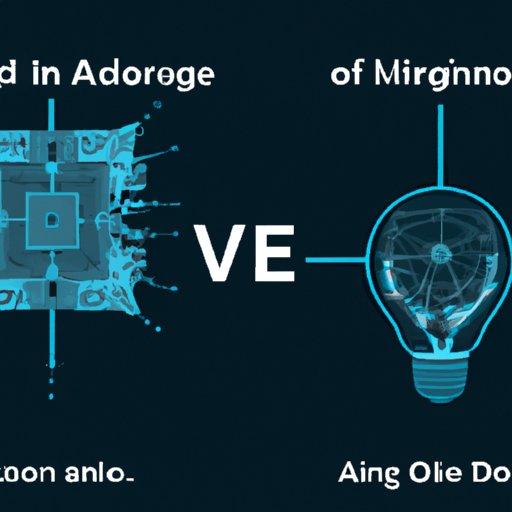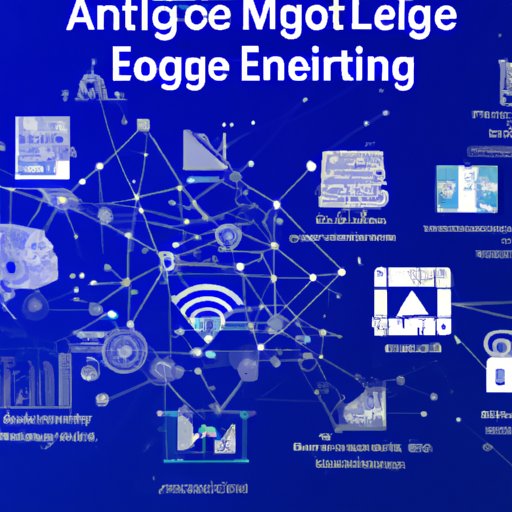Introduction
AI at the edge is a term used to describe the use of artificial intelligence (AI) technologies such as machine learning, deep learning, and natural language processing on devices that are located near or connected to the source of data. This allows for faster processing, improved accuracy, and lower latency than traditional cloud-based solutions. By leveraging the power of the edge, organizations can reduce costs, increase efficiency, and improve customer experiences.

Exploring the Basics of AI at the Edge: What It Is and How It Works
AI at the edge is a rapidly growing area of technology that relies on AI technologies such as machine learning and deep learning to process data closer to the source. By using AI at the edge, organizations can take advantage of lower latency and reduced costs while still maintaining high levels of accuracy and performance. The key components of AI at the edge include:
- Edge Computing: Edge computing refers to the process of running computations close to the data source, rather than in the cloud. This decreases latency and improves performance.
- IoT Devices: IoT devices are connected devices that can collect, analyze, and transmit data. They are an integral part of AI at the edge as they provide the necessary data for analysis.
- Machine Learning: Machine learning is a subset of AI that enables computers to learn from data without being explicitly programmed. In AI at the edge, machine learning algorithms are used to make decisions and predictions based on data collected by IoT devices.
- Deep Learning: Deep learning is a subset of machine learning that uses layered neural networks to process large amounts of data and make accurate predictions. It is increasingly used in AI at the edge.
- Natural Language Processing (NLP): NLP is a branch of AI that deals with understanding and generating human language. It is often used in AI at the edge to interpret and respond to user requests.
In addition to the components listed above, AI at the edge also includes other technologies such as facial recognition, object detection, and voice recognition. All of these technologies are used together to enable faster, more accurate processing of data at the edge.

AI at the Edge: A Comprehensive Guide to Understanding Its Benefits and Applications
AI at the edge offers a number of benefits, including lower latency, improved accuracy, and cost savings. These benefits can be applied to a variety of applications, ranging from intelligent transportation systems to smart homes and factories.
Advantages of AI at the Edge
One of the main advantages of AI at the edge is its ability to reduce latency. By running computations closer to the source, AI at the edge reduces the amount of time needed to process data, resulting in faster responses and better performance. For example, in self-driving vehicles, AI at the edge can help detect objects faster, allowing the vehicle to react more quickly to changes in the environment.
Another benefit of AI at the edge is improved accuracy. By running computations locally, AI at the edge eliminates the need to send data to the cloud for processing, resulting in higher accuracy and fewer errors. Additionally, AI at the edge can reduce costs by eliminating the need for expensive cloud infrastructure. By running computations locally, organizations can save money on bandwidth and storage.
Different Types of AI at the Edge
There are several different types of AI at the edge, each with its own set of benefits and applications. The most common types of AI at the edge include:
- Real-Time Analytics: Real-time analytics is a type of AI at the edge that enables organizations to quickly process and analyze data as it is collected. This can be used to provide insights into customer behavior or to identify potential problems before they become too serious.
- Image Recognition: Image recognition is a type of AI at the edge that is used to identify objects in images or videos. This can be used for facial recognition, object detection, and other applications.
- Natural Language Processing (NLP): NLP is a type of AI at the edge that enables machines to understand and generate human language. It is commonly used for chatbots, virtual assistants, and other text-based applications.
- Predictive Analytics: Predictive analytics is a type of AI at the edge that enables organizations to predict future trends and outcomes based on past data. This can be used to inform business decisions, optimize operations, and more.
Examples of AI at the Edge in Use
AI at the edge is being used in a variety of ways, from self-driving cars to smart homes and factories. Here are some examples of AI at the edge in action:
- Self-Driving Cars: Self-driving cars rely on AI at the edge to quickly process and interpret data from sensors, cameras, and other sources. This allows the car to make decisions and react to its environment in real-time.
- Smart Homes: Smart homes use AI at the edge to monitor and control devices such as lights, thermostats, and security systems. This allows homeowners to automate their homes and save energy.
- Smart Factories: Smart factories use AI at the edge to monitor and control manufacturing processes. This can help improve safety and productivity, reduce costs, and optimize operations.

Harnessing the Power of AI at the Edge: The Pros and Cons
While AI at the edge offers many benefits, there are also a few potential drawbacks to consider. Here are some of the pros and cons of using AI at the edge:
Pros of AI at the Edge
- Reduced latency and improved performance
- Increased accuracy and fewer errors
- Cost savings by eliminating the need for cloud infrastructure
- Faster decision making and response times
Cons of AI at the Edge
- Potential security risks due to data being stored and processed locally
- High upfront costs for hardware and software
- Lack of scalability due to limited resources on edge devices
- Data privacy concerns due to data being stored and processed locally
Real-World Examples of AI at the Edge and Its Impact on Businesses
AI at the edge is being used by businesses around the world to improve customer experiences, optimize operations, and save costs. Here are some examples of businesses that are using AI at the edge:
- Tesla: Tesla uses AI at the edge to power its Autopilot feature, which allows the car to drive itself. This has enabled Tesla to reduce costs, improve safety, and provide customers with a more enjoyable driving experience.
- Amazon: Amazon uses AI at the edge to power its Alexa voice assistant. This allows customers to ask questions, control their smart home, and access other features with just their voice.
- Walmart: Walmart has implemented AI at the edge in its stores to monitor customer behavior and optimize inventory. This has allowed Walmart to improve customer satisfaction and increase sales.
These are just a few examples of businesses that are leveraging the power of AI at the edge. As AI at the edge continues to mature, more businesses will begin to utilize its benefits.
An Overview of AI at the Edge: What You Need to Know To Get Started
Implementing AI at the edge requires a few key steps. First, you’ll need to identify the data sources that will be used for analysis and determine the type of AI technology that will be used. Next, you’ll need to select the hardware and software needed to run the AI algorithms. Finally, you’ll need to develop the AI algorithms and deploy them on the edge device.
In addition to the steps listed above, you’ll also need to consider the security and privacy implications of running AI at the edge. As mentioned earlier, data stored and processed locally poses a potential security risk, so it’s important to ensure that your edge devices are properly secured and that any data collected is protected.
Conclusion
AI at the edge is an emerging technology that is being used by businesses around the world to reduce costs, improve performance, and increase accuracy. By leveraging the power of the edge, organizations can take advantage of lower latency and improved accuracy while still maintaining high levels of performance and accuracy. In addition, AI at the edge can provide cost savings by eliminating the need for expensive cloud infrastructure. With its many benefits, AI at the edge is sure to become an essential tool for businesses in the years to come.
(Note: Is this article not meeting your expectations? Do you have knowledge or insights to share? Unlock new opportunities and expand your reach by joining our authors team. Click Registration to join us and share your expertise with our readers.)
